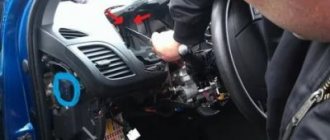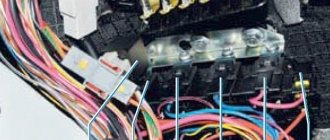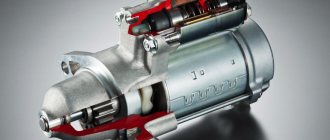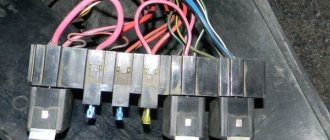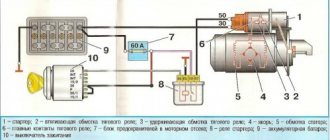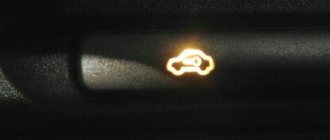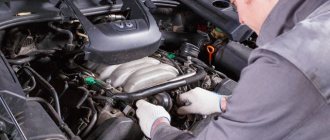Where is
The VAZ 2110 starter is located on the gearbox housing and is mounted on two studs. It is easier to see the starter in detail on 8-valve engines, since there is more free space in the engine compartment with such an engine. In a 16-valve engine, to see the starter, you need to remove the air filter housing.
Checking spark plugs and sparks
If the engine does not start within five seconds, there is no use turning the starter. You can try to start it again, but it’s unlikely to help. Moreover, operating the starter for too long can lead to overheating and even fire.
If you try to start a carburetor engine for a long time, gasoline will flood the spark plugs and make further starting attempts impossible in principle. The injectors have a purge mode, so the spark plugs can be dried without removing them from the car - you just need to press the gas pedal to the floor and turn the starter.
Clean working spark plugs VAZ 2110
But these are half measures. First of all, you should unscrew at least one spark plug, put the wire back on it and position the spark plug on the engine so that there is a distance of about three millimeters between the metal part of the spark plug and the metal of the engine. Turn on the starter and make sure that there is a uniform spark between the spark plug contacts.
Checking the spark in the spark plugs of the VAZ 2110
Do this check for each candle. If there is no spark on any spark plug, then there are global problems in the ignition system.
Starter relay (retractor)
The starter retractor relay is located on the starter itself and serves to move the bendix to the flywheel, and then engage with it. This relay often fails due to poor workmanship. It is quite easy to understand that the solenoid relay has failed; with such a breakdown, the starter will spin at idle, but the engine will not rotate, since the moving part of the drive (bendix) will not engage with the flywheel.
No contact
The starter starts with difficulty, before clicking. At first you are only slightly alarmed, but the situation repeats itself again and again: first it clicks, and only then the engine turns.
Have you checked your contacts lately? You need to start with the battery, maybe you are wrong to blame the starter, and the reason is oxidation of the terminals. Have you cleaned them and the starter clicks again? You need to check how your VAZ has ground contact with the body, and then the contacts of the starter itself, because they are also prone to oxidation.
Another test method: ask someone to turn the ignition key, while you yourself knock on the relay, using only a hard object. If it starts, it means that the closing contacts (nickels) are stuck, and it is easier to change the relay than to disassemble and repair it.
Possible starter failures
There can be a large number of starter breakdowns, but most often they are all of the same type. Below are all the most common starter failures.
Brush wear
Starter brushes are a copper-graphite part that conducts electric current. The brushes are in direct contact with the starter armature and rub against its commutator, conducting electric current. During long-term use, brushes become unusable due to friction and must be replaced. This breakdown is not expensive or complicated; you just need to remove the starter and replace the brushes.
Bendix wedge
The Bendix is directly connected to the flywheel and quite often, wear appears inside it or on its gears due to high load, which makes it impossible to start the car from the starter. By design, Bendix is an overrunning clutch that rotates freely in one direction and is locked when rotating in the other direction. This part is sold separately and can be replaced as soon as possible.
Gearbox failure
The VAZ 2110 starter is geared. This modification allows you to reduce the load on the battery and rotate the engine crankshaft much easier and faster due to the additional ratios. Quite often, wear appears on the gears, which can lead to jamming or even breakdown of the entire gearbox.
Winding break
Since large currents flow in the starter, the winding in it is quite powerful and can withstand large currents, but sometimes a large cross-section of wires is not able to preserve the winding and it burns out, rendering the starter unusable. Such a breakdown can be repaired by replacing the rotor.
Solenoid relay
The retractor is an electromagnetic part that is retracted under the action of an electromagnetic force, driving the bendix inward and engaging it with the flywheel. Inside the relay structure there is a regular coil, which quite often burns out and damages the starter.
Almost all starter failures can be repaired by replacing the broken part with a new one.
The overrunning clutch has failed
A cold engine starts without the slightest problem. You are driving quietly, stopping somewhere - to go to the store or for other matters. You return a few minutes later and are faced with a problem: the starter clicks, but refuses to work. And only after the engine has cooled down the car starts.
The first culprit in this situation is the overrunning clutch (popularly called Bendix, from the name of the well-known manufacturer of this part). It is better to replace it with a gearbox.
But you check and there is no malfunction? The next line is the wires going to the battery. Examine them carefully. It is quite possible that replacing the wire will solve all the issues.
There may be another situation: while on the road, the radio starts to turn off spontaneously, despite your attempts to turn it on. Having stopped to look and turned off your VAZ 2110, you soon discover that you cannot get the starter to crank. We checked the battery, everything is fine, but the car, which previously started normally, suddenly struggles.
You start pushing, and it works, everything works again. Almost certainly the problem is in the Bendix.
The starter doesn't turn over
There are many reasons why the starter does not work, but first of all you need to check the most common reasons why the engine will not start.
Checking contacts on the battery
Often the reason when the starter does not turn is due to loose terminals on the battery or their oxidation. It is enough just to clean the oxidized terminals from chemical reactions and tighten them with a force that will ensure reliable contact.
Battery discharge
Quite often, especially in winter, after a period of inactivity, the car’s battery may discharge, and thickened oil during parking will not allow the weak battery to rotate the crankshaft with the starter. You can check the battery with a regular multimeter; in winter its voltage should not be less than 12V, in summer not less than 11V. This voltage is not an indicator of the battery charge; at such values it is better to charge the battery.
Egnition lock
In some cases, the contact part of the ignition switch may fail. This is due to aging or poor quality parts. In this case, when turning the key, the contacts will not close to turn on the starter.
Winding break
If the winding on the stator or rotor of the starter breaks, the magnetic field that rotates the armature will not appear and the starter armature will not move.
Typical starter malfunctions and their causes
If the engine refuses to start, then it is quite possible that the reason lies in the performance of the starter device, but this will need to be clarified. Turn the ignition key all the way, then listen to the operation of the unit. If you hear that the electric motor is cranking and the relay is clicking, then most likely the reason lies in a malfunction of the clutch or gear unit. In practice, the clutch is often the cause of the malfunction; if this is the case, then, most likely, the bendix will have to be changed (the author of the video is the Sibiryak54 channel).
The reason may also be the gears, in particular their wear. Wear can be determined after dismantling and disassembling the mechanism - teeth on worn gears may be knocked off. If the starter unit refuses to click when you try to start the engine, then most likely the reason lies in the lack of voltage on the relay or this element has failed. To verify that the problem is with the relay, put the car on the parking brake, disconnect the wire from the relay, and connect another wire connected directly to the battery. If as a result of these manipulations the relay works, then check the switch itself, that is, the lock, connection wiring, and safety devices.
If, when trying to start the engine, the unit turns very slowly or does not turn at all, then troubleshooting is carried out as follows:
- If there is voltage in the circuit, then most likely the brushes or windings have failed.
- If there is no voltage, then perhaps the contact of the relay with the electrical circuit is poor. It is necessary to check the quality of the connection; there is a possibility that the contacts are simply dirty and will need to be cleaned. For cleaning, use a steel brush or fine-grained sandpaper.
Photo gallery “Starter malfunctions 2110”
2. Damaged relay
Replacing the VAZ 2110 starter
To remove the starter, you need to prepare a tool that will be needed during the work process.
Required tool:
- Ratchet;
- Extension;
- Head 13mm;
- Open-end wrench 10mm;
- Open-end wrench 13mm;
Step-by-step instruction
- Disconnect the negative terminal from the battery
- We dismantle the air filter box together with the mass air flow sensor
- Unscrew the wires from the starter
- Unscrew the nuts securing the starter to the gearbox
- Removing the starter
We close the starter in the French special cases
Lada Priora Sedan Logbook Preparing for winter. Starter
Access to the starter is always open from under the bottom - you just need to remove the crankcase protection. An example is in the photo below.
Under the bottom of Renault Megane 2
It is difficult to reach the starter from the engine compartment. In the best case, it is closed by a filter (VAZ), in the worst case, by a battery. You can remove the filter, but what about the battery?
Starter installation location (circle)
Everything is done so that the starter can be changed, repaired, but not short-circuited.
What does terminal S look like?
On Renault cars, the terminal looks like a threaded outlet. The nut screwed onto it is “white”, although it itself is made of copper (see photo).
Starter Renault Logan, phase 1
We have already talked about the VAZ - they use a plug. If you remove it, you can see the “petal”.
The starting method using a screwdriver is not the best. The problem is limited access.
50 Amps
We are going to short-circuit the starter with a screwdriver, but at the connection points where the current will flow, it may “stick”. In this case, without unnecessary panic, remove the negative terminal from the battery.
To remove the minus terminal, you need a 10mm open-end wrench. Keep it with you.
When the immobilizer is a hindrance
The engine stalled unexpectedly, the starter refuses to turn it, and it also won’t start with a “push.” The battery was checked - charged, serviceable, terminals clean and in place.
However, your immobilizer is working, and most likely the problem is there. The protection is triggered, the engine is silent. It is necessary to tow the VAZ 2110 to a car service center for diagnostics.
In order to bypass and disable the immobilizer yourself, it is recommended that you read the following article: https://vazweb.ru/desyatka/elektrooborudovanie/kak-otklyuchit-immobilayzer.html
The injector can also fail
In fact, we have sorted out almost all starter malfunctions associated with the operation of the VAZ 2110 carburetor engine. There are also injection engines, which are fashionable to install on cars today. Yes, they are more environmentally friendly, reduce fuel consumption, increase power performance, and the engine does not require warming up in winter.
But the injector is unlikely to “rejoice” at insufficiently high-quality gasoline; its repair is more expensive, since it operates under the control of a microprocessor. And in our operating conditions, this can also be the reason why the starter does not work well. Perhaps the injector requires cleaning (and this should be done regularly, since low-quality gasoline contributes to the deposition of resins and impurities).
Diagnosis and Troubleshooting
It is relatively simple to verify that the electrical network is faulty - this can be done without removing the fuel pump. When the sound of its operation is not heard when the ignition is turned on, you must immediately check the fuse responsible for this circuit. It is installed in a block mounted at the bottom in front of the front passenger seat. You need to remove the block cover, find the fuse marked F3, rated for 15 A, and replace it. This kind of work can be done on the road.
If the operation of the fuel pump has not resumed, you should switch your attention to relay K2, located in the same block. It closes the power circuit of the pumping device based on a signal from the controller. You can also check the serviceability of the relay in road conditions, for which you will need a piece of copper wire
Diagnostics are carried out in the following order:
You can also check the serviceability of the relay in road conditions, for which you will need a piece of copper wire. Diagnostics are carried out in the following order:
- Remove relay K2 from the connector.
- Turn on the ignition.
- Using a wire, connect the contacts marked “30” and “87”; the numbers are marked on the relay. Another option is to apply power to pin “11” located in the diagnostic connector. The +12 V voltage can be taken nearby, from the cigarette lighter.
- If you hear the pump humming, then you need to change relay K2.
If after the above manipulations the unit is still “silent”, it is necessary to check the integrity of the wiring and the reliability of the contact at the place of its connection. This will require a device, so it will not be possible to carry out such work in the middle of a field. Unless you can check the serviceability of the fuel pump itself by disconnecting the connectors from it and supplying 12 V directly from any convenient source. If the pump still does not hum, it should be replaced.
It will not be possible to diagnose insufficient fuel supply to the injectors under road conditions, unless you carry a pressure gauge with a corresponding hose for connection to the fuel rail. The amount of gasoline supplied is characterized by the pressure in the network, to measure which you will need a pressure gauge. The check is performed as follows:
- Twist off the plastic cap covering the diagnostic fitting. It is located at the end of the fuel rail and is a regular spool.
- Press the spool rod to release the pressure in the line. In case of gasoline leakage, place a small container under the spool. Perhaps the malfunction will make itself felt already at this stage if there is no pressure in the network and no fuel flows from the fitting.
- Unscrew the spool and put the hose from the pressure gauge onto the fitting. With the ignition off, apply 12 V directly to the pump. To clearly record the readings, it must work for at least 10 seconds.
If the pressure is below 3.6 bar, you must first change the coarse filter. If this does not help, then you will have to check the RTD and the tightness of the injectors. This is the only way to accurately determine the source of the problem.
Replacing a mechanical fuel pump
Unscheduled replacement of a mechanical type device takes place in the following order:
- We dismantle the air purification filter.
- Remove the fuel supply line to the fuel pump.
- First loosen the tightening of the clamp.
- Remove the fuel supply line to the carburetor.
- Unscrew the fasteners of the product.
Installation is in the reverse order. At the same time, do not forget to look at the arrows on the products showing the direction of movement of fuel to the carburetor.
The question is often asked, how to check the VAZ 2110 unit in operation? To do this, it is necessary to tighten the screws on the cover with the pump lever depressed and test the carburetor accelerator pump.
Price issue
Many owners are interested in how much this device costs and which starter is best to choose for the VAZ 2110. A standard unit from AvtoVAZ will cost about 5,000 rubles. Imported analogues are also suitable for the VAZ 2110. For example, you can take the BOSCH model, which costs about 10 thousand rubles.
There are also budget freelance models on the automotive market; they can be purchased for 3 thousand rubles. Whatever the starter, it should come with a warranty. Of course, the imported version works better, but the standard device has an excellent price-quality ratio.
